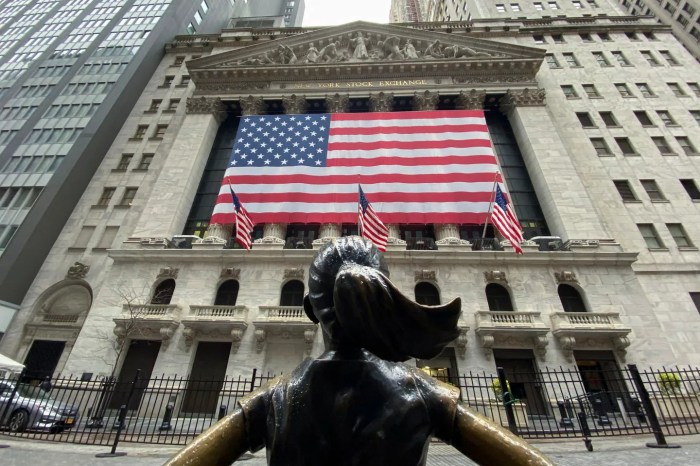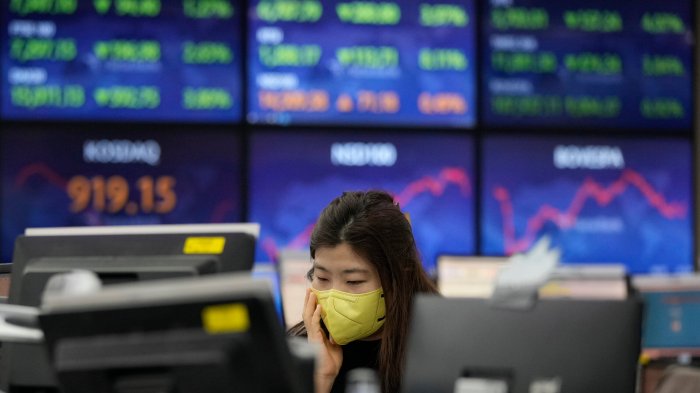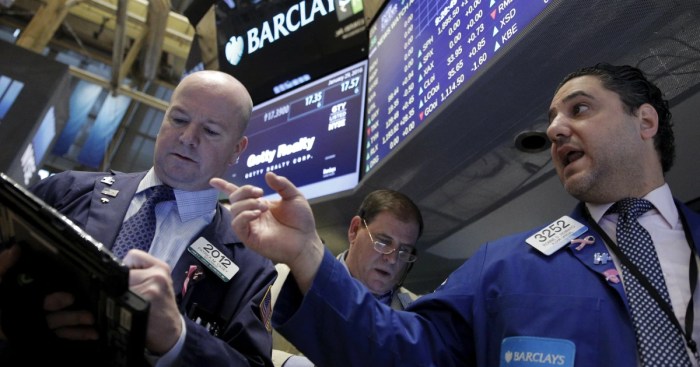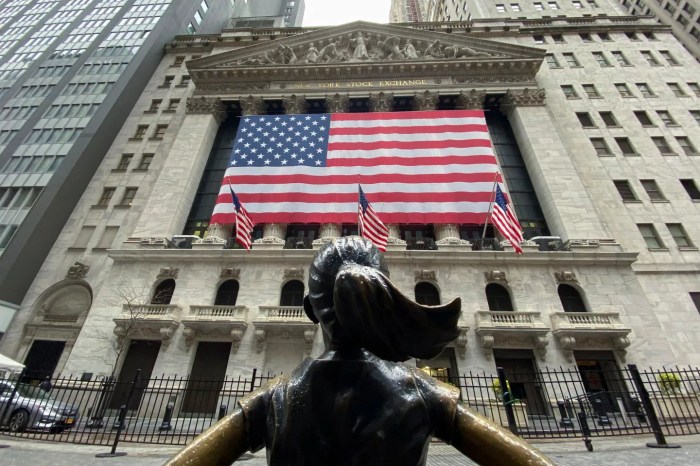
Wall Street Changes Its View on the Stock Market
Wall Street changes its view on the stock market, a shift that ripples through the financial world. The recent adjustments in sentiment, driven by evolving economic conditions and market indicators, have sparked a wave of analysis and speculation. This change in perspective is impacting investment strategies, sector performance, and the broader economy.
Historically, Wall Street has cycled through periods of bullish optimism and bearish pessimism. Understanding these cycles is crucial for navigating the current market landscape. From inflation concerns to interest rate hikes, several factors are influencing Wall Street’s revised outlook.
Key indicators like corporate earnings, consumer spending, and global economic trends are being closely monitored for clues about the future direction of the market.
Wall Street’s Shifting Sentiment
Wall Street, the financial heart of the United States, is renowned for its influence on global markets. Its sentiment, often reflected in the movements of major stock indices, has a significant impact on investor confidence and economic activity. However, Wall Street’s view on the stock market is not static.
It ebbs and flows, influenced by a complex interplay of economic conditions, market trends, and investor psychology. This dynamic nature of Wall Street’s sentiment is best understood by examining its historical context, the current economic landscape, and the key indicators that have driven recent shifts.
Historical Context of Wall Street’s View
Wall Street’s history is marked by cycles of bull and bear markets, periods of sustained price increases and decreases, respectively. These cycles are driven by a combination of factors, including economic growth, interest rates, inflation, and investor confidence.
- The Roaring Twenties (1920s): This period witnessed a spectacular bull market fueled by rapid economic growth, technological advancements, and easy credit. However, the exuberance was short-lived, leading to the devastating stock market crash of 1929 and the Great Depression.
- The Post-World War II Boom (1940s-1970s): Following World War II, the US economy experienced a period of sustained growth, fueled by pent-up consumer demand and government spending. This period was marked by a strong bull market, with the Dow Jones Industrial Average (DJIA) rising significantly.
- The Tech Bubble (1990s): The late 1990s witnessed a surge in technology-related stocks, driven by the rise of the internet and e-commerce. However, the bubble burst in 2000, leading to a sharp correction in the stock market.
- The Global Financial Crisis (2008-2009): The subprime mortgage crisis triggered a global financial meltdown, leading to a steep decline in stock prices and a severe recession.
- The Post-Crisis Recovery (2009-2020): After the financial crisis, the US economy recovered, aided by government stimulus measures and low interest rates. This period was characterized by a strong bull market, with the DJIA reaching record highs.
Current Economic Conditions and Factors Influencing Wall Street’s Sentiment
The current economic landscape is characterized by several factors that are influencing Wall Street’s recent change in sentiment.
- Inflation: Rising inflation, driven by supply chain disruptions and strong consumer demand, has eroded purchasing power and increased business costs. This has led to concerns about the Federal Reserve’s (Fed) response and its potential impact on economic growth.
- Interest Rates: The Fed has been aggressively raising interest rates to combat inflation, increasing borrowing costs for businesses and consumers. This has slowed economic growth and raised concerns about a potential recession.
- Geopolitical Uncertainty: The ongoing war in Ukraine, tensions with China, and other geopolitical events have created uncertainty and volatility in global markets.
- Supply Chain Disruptions: Ongoing supply chain disruptions have contributed to inflation and hampered business operations, creating challenges for companies across various sectors.
Key Indicators That Have Led Wall Street to Adjust Its Outlook
Several key indicators have contributed to Wall Street’s recent shift in sentiment, signaling a potential slowdown in economic growth and a shift towards a more cautious outlook.
- Earnings Reports: Corporate earnings have been impacted by rising inflation and supply chain disruptions, leading to concerns about profit margins and future growth prospects.
- Consumer Confidence: Consumer confidence has declined in recent months, reflecting concerns about inflation and the economic outlook.
- Yield Curve Inversion: The yield curve, which reflects the difference between short-term and long-term interest rates, has inverted in recent months. This is historically seen as a leading indicator of a recession.
- Inflation Data: Inflation data has remained stubbornly high, prompting concerns about the Fed’s ability to tame inflation without triggering a recession.
Market Predictions and Strategies

Wall Street’s shifting sentiment has sparked a wave of speculation about the future direction of the stock market. With the recent volatility and uncertainty, investors are eager to understand the prevailing market predictions and strategize accordingly. This section delves into the key arguments presented by major Wall Street firms and their implications for investors.
Analysis of Market Predictions, Wall street changes its view on the stock market
Major Wall Street firms are divided in their outlook on the market. Some remain optimistic, citing factors like strong corporate earnings and continued economic growth. Others are more cautious, highlighting concerns like inflation, rising interest rates, and geopolitical tensions.
- Optimistic Outlook:Firms like Goldman Sachs and Morgan Stanley maintain a bullish stance, forecasting continued growth in the stock market. They point to robust corporate earnings, particularly in sectors like technology and consumer discretionary. They also highlight the resilience of the US economy, citing strong consumer spending and a healthy labor market.
- Cautious Outlook:Firms like JPMorgan Chase and Bank of America are more cautious, anticipating a potential slowdown in economic growth and a correction in the stock market. They cite factors like rising inflation, aggressive interest rate hikes by the Federal Reserve, and ongoing supply chain disruptions.
These factors could weigh on corporate profits and lead to a decline in stock prices.
Investment Strategies in a Shifting Market
The diverse market predictions necessitate a nuanced approach to investment strategies. Investors should consider their risk tolerance, investment horizon, and specific financial goals when making decisions.
- For those seeking growth:Investing in sectors like technology, healthcare, and renewable energy could offer potential upside. However, it’s crucial to remember that these sectors are generally considered more volatile.
- For those seeking stability:Investing in value stocks, dividend-paying companies, and defensive sectors like consumer staples and utilities might provide a more stable return. These sectors are often less affected by economic downturns.
- Diversification:It’s always advisable to diversify your portfolio across different asset classes, including stocks, bonds, and real estate. This helps mitigate risk and potentially enhance returns over the long term.
Portfolio Adjustments by Wall Street Firms
In response to the changing market conditions, Wall Street firms are adjusting their portfolios and investment strategies. Some are increasing their exposure to value stocks and sectors expected to benefit from inflation, while others are reducing their equity holdings and increasing their cash positions.
- Shifting Sector Allocation:Firms like BlackRock and Vanguard are increasing their allocation to value stocks, particularly in sectors like financials and energy. They believe these sectors are well-positioned to benefit from a rising interest rate environment and a rebound in economic activity.
- Cash Management:Some firms are also increasing their cash positions to preserve capital and maintain flexibility in a volatile market. This strategy allows them to deploy capital opportunistically when market conditions improve.
Impact on Specific Sectors and Companies
Wall Street’s revised outlook on the stock market has significant implications for various sectors and companies. The changing sentiment and market predictions will likely influence investment strategies and corporate performance across different industries.
Wall Street’s recent shift in sentiment towards the stock market might be influenced by a surprising surge in the housing sector. The latest data reveals that US home building surged past expectations in July amidst high demand for new homes , a strong indicator of a resilient economy and potential for continued growth.
This positive development could be a key factor in Wall Street’s renewed optimism about the stock market’s future performance.
Impact on Technology Sector
The technology sector is often seen as a bellwether for the broader market, and its performance can significantly impact investor sentiment. The sector’s growth potential and innovation drive are key factors influencing Wall Street’s view. * Potential Positive Impacts:
Increased investment A positive outlook on the market could lead to increased investment in technology companies, particularly those with strong growth prospects and disruptive technologies.
Higher valuations Rising investor confidence could drive up valuations for technology companies, leading to potential gains for shareholders.
Increased innovation With more capital available, technology companies may be able to accelerate their research and development efforts, leading to further innovation and growth.
Potential Negative Impacts
Valuation correction If the market outlook turns negative, technology companies, often characterized by high valuations, could experience significant price corrections.
Reduced investment A pessimistic market sentiment could lead to decreased investment in the technology sector, potentially slowing growth.
Competition
Wall Street’s recent shift in sentiment towards the stock market might be influenced by a slew of recent events, including the news that Elon Musk unveils dramatic changes to Twitter logo and birds to vanish. While this might seem like a purely social media change, it could ripple through the tech sector and impact investor confidence in the broader market.
Wall Street’s recent shift in sentiment towards the stock market is a reminder that even seasoned professionals can be surprised by the market’s unpredictable nature. It’s a stark contrast to the steady, long-term approach adopted by a couple featured in this article , who reached a million-dollar net worth in their 30s by focusing on index funds and a small portion of individual stocks.
Their success underscores the importance of a disciplined investment strategy, regardless of Wall Street’s short-term fluctuations.
A positive market outlook could lead to increased demand for Apple products and services, boosting revenue and profits. Conversely, a negative market sentiment could lead to reduced consumer spending, impacting Apple’s financial performance.
Microsoft Microsoft, a major player in cloud computing and software, could benefit from increased investment in technology infrastructure. A positive market outlook could lead to greater adoption of Microsoft’s cloud services, driving revenue growth. However, a negative outlook could lead to reduced spending on cloud services, impacting Microsoft’s bottom line.
Impact on Energy Sector
The energy sector is particularly sensitive to global economic conditions and energy demand. Wall Street’s view on the market can significantly impact energy prices, investment in exploration and production, and the transition to renewable energy.* Potential Positive Impacts:
Increased demand A strong economy could lead to increased demand for energy, particularly oil and gas, driving up prices and boosting profits for energy companies.
Investment in renewable energy A positive market outlook could encourage investment in renewable energy sources, such as solar and wind power, as investors seek long-term growth opportunities.
Potential Negative Impacts
Reduced demand A recession or economic slowdown could lead to reduced energy demand, putting downward pressure on prices and impacting energy company profits.
Regulatory uncertainty Government policies and regulations related to energy production and consumption can significantly impact the energy sector. Uncertainty surrounding these policies could discourage investment and create volatility in the market. Examples:* ExxonMobil:As one of the world’s largest oil and gas producers, ExxonMobil’s financial performance is closely tied to oil prices.
A positive market outlook could lead to higher oil prices, boosting ExxonMobil’s revenue and profits. However, a negative market sentiment could lead to lower oil prices, impacting ExxonMobil’s financial performance.
NextEra Energy NextEra Energy, a leading provider of renewable energy, could benefit from increased investment in renewable energy sources. A positive market outlook could encourage investors to allocate capital to renewable energy projects, driving growth for NextEra Energy. However, a negative market sentiment could lead to reduced investment in renewable energy, impacting NextEra Energy’s financial performance.
Implications for the Broader Economy: Wall Street Changes Its View On The Stock Market

Wall Street’s shifting sentiment towards the stock market can have significant ripple effects throughout the broader economy. This is because the stock market is not just a barometer of investor confidence but also a crucial driver of economic activity.
The Relationship Between Stock Market Performance and Economic Growth
The stock market and economic growth are intricately linked. A robust stock market often signals a healthy economy, attracting investors and boosting business confidence. Conversely, a declining stock market can indicate economic weakness, leading to reduced investment and consumer spending.
Historically, there has been a strong correlation between stock market performance and economic growth. For instance, the S&P 500 index has historically risen alongside GDP growth, indicating a positive relationship between the two.
However, it’s important to note that the relationship is not always straightforward. While a healthy stock market can contribute to economic growth, it’s not the sole determinant. Other factors, such as government policies, global economic conditions, and technological advancements, also play a significant role.
The Impact of Investor Sentiment on Consumer Confidence and Business Investment
Changes in investor sentiment can have a profound impact on consumer confidence and business investment. When investors are optimistic about the stock market, they are more likely to invest in businesses, leading to increased economic activity. This, in turn, can boost consumer confidence, leading to higher spending.Conversely, when investor sentiment is negative, businesses may be hesitant to invest, leading to reduced economic activity.
This can also dampen consumer confidence, resulting in lower spending.
- Consumer Confidence:When investors are bullish, consumers tend to feel more optimistic about the economy and their own financial prospects. This can lead to increased spending on durable goods, such as cars and appliances, and discretionary items, such as vacations and entertainment.
Conversely, when investors are bearish, consumers may become more cautious, leading to a decline in spending.
- Business Investment:When investors are optimistic, businesses are more likely to invest in new projects, expand their operations, and hire new employees. This can lead to economic growth and job creation. Conversely, when investors are pessimistic, businesses may delay or cancel investment projects, leading to a slowdown in economic activity.
Investor Considerations

Wall Street’s revised outlook on the stock market presents a complex landscape for investors, requiring careful consideration of their individual circumstances and risk tolerance. Understanding the nuances of this shift and its implications for various investment strategies is crucial for making informed decisions.
Investment Strategies for Different Investor Profiles
Investors with diverse risk appetites and financial goals should adopt different investment strategies in response to Wall Street’s revised market outlook. The table below Artikels some potential strategies based on investor profiles:
| Investor Profile | Investment Strategy | Rationale |
|---|---|---|
| Aggressive Investor | Growth-oriented portfolio with a higher allocation to equities, particularly in sectors expected to benefit from the revised market conditions (e.g., technology, healthcare). | Aggressive investors are willing to take on higher risk for potentially higher returns. They can capitalize on growth opportunities in sectors expected to outperform. |
| Moderate Investor | Balanced portfolio with a mix of stocks and bonds, emphasizing value stocks and sectors with stable earnings. | Moderate investors seek a balance between growth and preservation of capital. Value stocks and stable sectors offer a degree of protection against market volatility. |
| Conservative Investor | Defensive portfolio with a higher allocation to bonds, fixed-income securities, and dividend-paying stocks. | Conservative investors prioritize capital preservation and income generation. Bonds and dividend-paying stocks offer stability and consistent returns. |
Potential Risks and Opportunities
The current market environment presents both risks and opportunities for investors. Understanding these factors is essential for making informed investment decisions:
Risks
- Market Volatility:The revised market outlook suggests increased volatility, potentially leading to short-term price fluctuations and market corrections.
- Interest Rate Hikes:Rising interest rates can impact bond yields and potentially decrease the value of existing bond holdings.
- Inflation:Persistent inflation can erode purchasing power and increase the cost of living, impacting corporate earnings and consumer spending.
- Geopolitical Uncertainty:Global conflicts and political instability can create market uncertainty and disrupt supply chains.
Opportunities
- Value Stocks:The revised market outlook may present opportunities to invest in undervalued companies with strong fundamentals.
- Dividend-Paying Stocks:In a period of market uncertainty, dividend-paying stocks can offer a reliable source of income and potential capital appreciation.
- Defensive Sectors:Sectors like healthcare and consumer staples tend to be less sensitive to economic cycles and can provide a degree of portfolio stability.
- Alternative Investments:Investors may consider exploring alternative investments, such as real estate, commodities, or private equity, to diversify their portfolios and potentially enhance returns.
Advice for Individual Investors
Navigating the evolving market conditions requires a proactive approach:
- Develop a Clear Investment Plan:Define your investment goals, risk tolerance, and time horizon. This will help you make informed decisions aligned with your financial objectives.
- Diversify Your Portfolio:Spreading your investments across different asset classes, sectors, and industries can mitigate risk and potentially enhance returns.
- Stay Informed:Monitor market trends, economic indicators, and company news to stay abreast of developments that may impact your investments.
- Seek Professional Advice:Consider consulting with a financial advisor who can provide personalized guidance and help you develop a tailored investment strategy.
- Be Patient and Disciplined:Market fluctuations are inevitable. Avoid making impulsive decisions based on short-term market movements and stick to your long-term investment plan.






